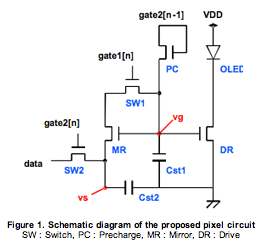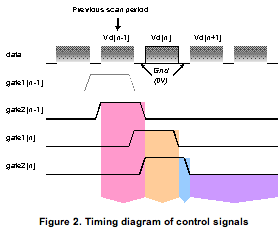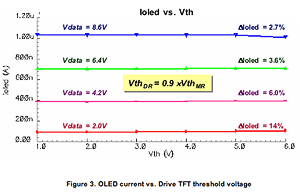
Design of a-Si:H TFT Pixel Electrode Circuit for AM-OLED
Juhn S. Yoo, Hojin Lee and Jerzy Kanicki
 Amorphous silicon thin film transistor (a-Si:H TFT) is a cost effective technology for active-matrix organic light-emitting display (AM-OLED) application due to the existing infrastructures of the active-matrix liquid-crystal display (AM-LCD) industry. However, a-Si:H TFT still has some critical electrical stability issues to be addressed that could be problematic for OLED current driving device. The stability issues come from degradation of the TFT’s electrical characteristics under long-term bias-temperature stress. Positive shift of the a-Si:H TFT threshold voltage reduces the luminance of the AM-OLED leading to reduced overall display lifetime. Furthermore, differential ageing of TFT electrical characteristics cause some undesirable visual defects, such as image sticking or ghost effects. Amorphous silicon thin film transistor (a-Si:H TFT) is a cost effective technology for active-matrix organic light-emitting display (AM-OLED) application due to the existing infrastructures of the active-matrix liquid-crystal display (AM-LCD) industry. However, a-Si:H TFT still has some critical electrical stability issues to be addressed that could be problematic for OLED current driving device. The stability issues come from degradation of the TFT’s electrical characteristics under long-term bias-temperature stress. Positive shift of the a-Si:H TFT threshold voltage reduces the luminance of the AM-OLED leading to reduced overall display lifetime. Furthermore, differential ageing of TFT electrical characteristics cause some undesirable visual defects, such as image sticking or ghost effects.
In order to overcome these issues, and to fully benefit from the existing AM-LCD infrastructures, we introduce a pixel circuit capable of suppressing the effect of the a-Si:H TFT threshold voltage shift to enhance the reliability of AM-OLED without requiring any development of complicated drive ICs. A novel pixel circuit has been designed for electrically stable AM-OLED with the a-Si:H TFT backplane and top-anode organic light-emitting diode structure.
 As shown in Figure 1, each pixel circuit is composed of a power line (VDD), two control lines (Gate1, Gate2), two capacitors (Cst1, Cst2) and five TFTs; two switch TFTs (SW1, SW2), a pre-charge TFT (PC), a drive TFT (DR) and a mirror TFT (MR). The pixel circuit operates in four stages; pre-charge, program, restore and drive, as illustrated in Figure 2. As shown in Figure 1, each pixel circuit is composed of a power line (VDD), two control lines (Gate1, Gate2), two capacitors (Cst1, Cst2) and five TFTs; two switch TFTs (SW1, SW2), a pre-charge TFT (PC), a drive TFT (DR) and a mirror TFT (MR). The pixel circuit operates in four stages; pre-charge, program, restore and drive, as illustrated in Figure 2.
Synthesizing all the parasitic effects and optimizing all the design parameters, electrical stability of the proposed pixel circuit has been verified using SPICE simulations. According to the experimental data from current stress test in common-gate mode, difference of threshold voltage between drive and mirror TFT is set to 10%. The data voltage (Vdata) from 2 to 8.6V is applied to drive OLED current from 100nA to 1µA, as IOLED variation verses the drive TFT threshold voltage is shown in Figure 3. The simulated results verify that the proposed pixel circuit compensates for OLED current changes when a-Si:H TFT threshold voltage shift up to 5V is observed, resulting in maximum IOLED variation of less than 15%, even when the mirror a-Si:H TFTs have 10% threshold voltage difference. These results are acceptable for a-Si:H TFT AM-OLEDs to be used in number of products. 
This work is funded and supported by LG.PHILIPS LCD, Ltd.
top
|

